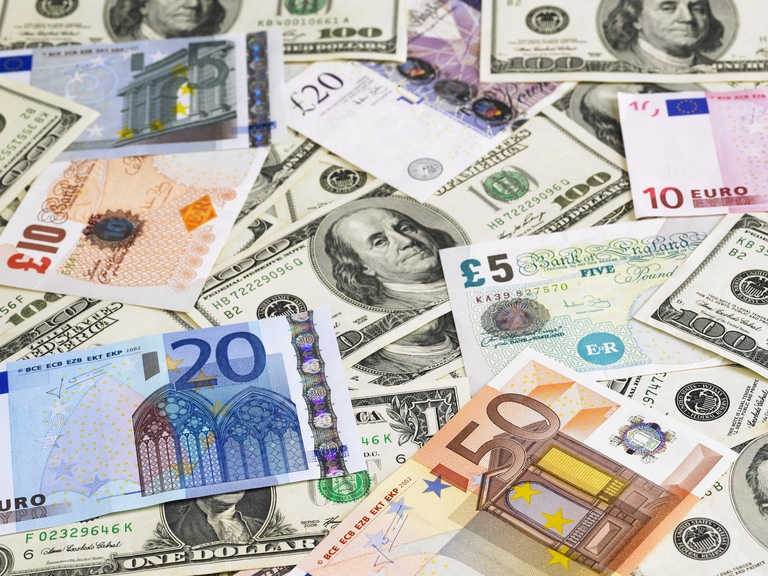Markets in Europe have seen another day of strong gains after the Nikkei 225 closed at its highest levels since 1990 and finished the week higher by 4.8%.
Europe
This momentum translated into the European session, with the German DAX taking up the challenge and posting a new record high above 16,300, with the gains being driven by optimism that markets would have one less thing to worry about next week, with respect to a successful resolution of US debt ceiling negotiations.
The FTSE100 has once again been the laggard with weakness in the retail and construction sector acting as a drag today, with JD Sports getting a bit of a shoeing after a profits warning from its US peer Foot Locker.
Next and Burberry are also a little softer despite a modest improvement in UK consumer confidence for April.
House builders are also on the back foot, with Persimmon, Berkeley Group and Taylor Wimpey all underperforming as UK gilt yields get dragged higher on the back of the rise in US yields, with 5-year yields rising to their highest levels since last October, while 2-year yields are back above 4%, which is bad news for mortgage holders who might soon be coming off their fixed rates.
We are seeing some positives today with a rebound in BT Group, at the end of what has been a torrid week for the telecoms sector. On the plus side the FTSE100 has managed to finish the week higher thus breaking a run of 3 successive weekly declines, but the gains have been pathetic, when compared to its overseas peers this week.
US
US markets have picked up where they left off yesterday, opening higher as the breakouts seen in the Nasdaq 100 and S&P500 yesterday help to build further momentum, with the Nasdaq 100 up over 3% this week, and the S&P500, approaching a 2% gain.
Yields have also continued to move higher in the wake of this week’s repricing of a possible US rate rise at the June meeting, and ahead of scheduled comments from Fed chair Jay Powell later today. The US 2-year yield has risen to 3-month highs above 4.3%.
Foot Lockershares have plunged after reporting a 9.1% decline in Q1 sales while missing on profits at $0.70c a share. Sales came in at $1.93bn, below forecasts of $2bn, with declines in sales in all their store chains, while gross margin declined 400bps. Inventories were also 25% higher than the same period a year ago. The company also downgraded its guidance for the new fiscal year, downgrading its sales forecasts to -6.5% to -8%, while slashing profits expectations to between $2 to $2.25c a share.
Nike, Dick’s Sporting Goods and Under Armour shares have also slipped back with the whole sector getting hit quite hard.
Agricultural equipment maker Deere and Co on the other hand has seen its shares rise as higher crop prices have prompted farmers to invest in new machinery, prompting the company to raise its full year guidance. Q2 revenues came in at $16.08bn, a big jump from last year’s $12bn, while profits surged from $2.1bn last year to just shy of $3bn, or $9.65c a share. Deere said the improved performance should see it generate profits for the year to come in between $9.25bn and $9.5bn.
FX
It’s been another positive week for the US dollar, with the biggest gains against the Japanese yen, although we’ve seen a modest pullback in the Japanese currency today, after the latest Japanese core CPI numbers saw prices edge back up to 3.4%, from 3.1% in March.
The higher inflation reading could raise concerns that inflation in Japan might be stickier than thought, with the Bank of Japan next due to meet on 16th June. With rates still negative the BOJ is well behind other central banks so it wouldn’t take much to shake the tree here to cause a few ripples if the central bank tweaks its YCC policy.
The New Zealand dollar has seen a strong rebound this week on speculation that the RBNZ could pull the trigger on another 50bps rate hike when it meets next week. Current market pricing is for a 25bps move; however, the recent budget might prompt a bigger hike, or a more hawkish disposition from the central bank.
The pound looks set to finish the week close to where it started, ahead of next week’s key April CPI numbers that are expected to see April inflation drop sharply into single digit territory from March’s 10.1% to somewhere in the low 8% area.
Despite yesterday’s decline crude oil prices look set to post their first positive week in over a month, with this week’s announcement that the US will look at refilling the SPR by 3m barrels between now and August at the start of the week helping to stop the rot. The more positive mood around a debt ceiling solution may be helping on the margins, but the main driver is going to be the SPR news.
Gold prices have been slapped down hard this week, dropping below $2,000 an ounce, and falling to their lowest levels since March as a stronger US dollar and higher yields diminish its shine.
Volatility
It was BT Group that provided the heavyweight price action at a stock specific level on Thursday after the company announced results and news of 55,000 layoffs. Although the plan is to see many vacated roles replaced by AI, the market failed to be enthused by the offer with the underlying price falling by around 10% at one point. One day volatility printed 100.62% against 37.57% for the month.
CMC’s proprietary basket of US listed; Chinese tech stocks was in focus after Alibaba – the heaviest weighted constituent – saw quarterly revenues fall short of expectations. News that it would spin off individual divisions did little to help either and the earnings miss acted as a drag on the wider sector, too. The basket had slipped more than 4% by the close, with one day volatility coming in at 66.59% against 41.61% on the month.
The Nikkei’s surge to 33-year highs this week has been driving price action in the Japanese equity index, with many investors asking just how far the rally will go. Year to date gains are already above 20%, and the break above 30,000 has been sufficient to propel one day volatility to 17.2% against 12.2% on the month.
And finally, the US Natural Gas contract advanced around 10% in the latter part of Thursday’s trade in what appeared to be a reaction to inventory data showing a smaller than expected weekly surplus. One day volatility advanced to 93.88% compared to 64.48% on the month.






